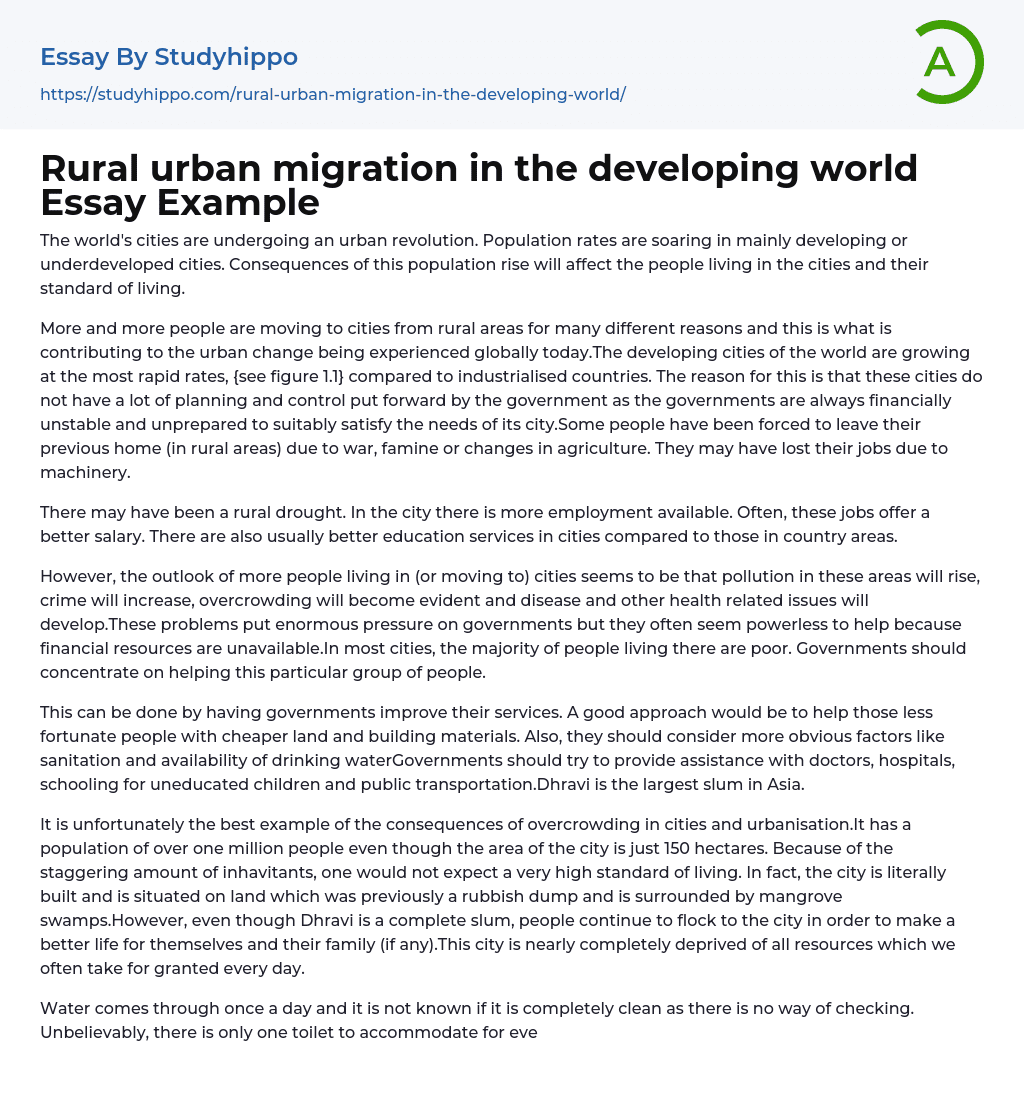

Rural urban migration in the developing world Essay Example
The rise in urban populations is having a notable effect on the welfare of residents in cities that are both developing and underdeveloped across the globe.
The swift expansion of cities worldwide is driven by various factors, such as deficient governmental planning and regulation plus the migration of people from rural areas to urban centers. The most substantial rise in population occurs in developing cities due to their financial instability and incapacity to fulfill their inhabitants' demands. Reasons for migrating from rural regions include war, famine, changes in agriculture, or technological advancements leading to job loss.
Although droughts may be more common in rural areas, cities generally provide greater employment prospects with increased salaries and superior educational institutions compared to their rural counterparts.
With the increasing migration of individuals to urban areas, there is a growing concern that problems like pollution, cr
...ime, overpopulation, illnesses and health-related issues will intensify. These challenges present a difficulty for governments who often face insufficient funding to provide assistance. Additionally, many city dwellers are impoverished and depend on government aid.
One way for governments to assist those in need is by offering affordable land and building materials. Access to clean drinking water and prioritizing sanitation are also important measures that should be taken. Governments should make an effort to support healthcare, education, and public transportation specifically for underprivileged individuals. Dhravi boasts the title of Asia's largest slum.
Even though Dharavi is an illustration of the detrimental consequences of urban overcrowding, it houses a population of more than one million individuals within only 150 hectares. The city's location on a previous landfill encircled by mangrove swamps, as well as its limited resources, would usually result in
substandard living conditions. However, people still move to Dharavi with aspirations to enhance their own and their families' lives. Despite being a full-fledged slum, essential resources are inadequate in this city.
The lack of means for verification makes it uncertain whether the water provided once a day is entirely safe, and the shocking fact that there is only one toilet available for every 6000 people results in disease and unsanitary conditions leading to daily deaths in the city. This inadequate state reflects challenges faced by developing or underdeveloped cities that become overpopulated, with urbanization causing a surge in population numbers worldwide and contributing significantly to air pollution - a pervasive issue across major global cities.
Cities with high levels of pollution, caused primarily by transportation, industry, and home heating, face significant health risks. Despite improvements in the past 50 years, smog still causes damage and fatalities. One example is Mexico City, a densely populated metropolis that has grown from 344,000 inhabitants to 1.7 million over four decades.
Over the course of 40 years, the population in the area has grown to 14 million people, which is more than Australia's total population of approximately 18 million. Despite this growth, efforts are being made by the government to manage migration and control further expansion. However, if resources become strained in heavily populated urban areas, there could be significant consequences.
The insufficiency of resources may lead to unfavorable conditions in cities, such as impure water, inadequate disease prevention measures, substandard housing, and even homelessness. This shortage results in an estimated annual death toll of 10 million people. Urbanization is an irreversible consequence caused by a shift towards technological, industrial and service-based
economies in the global economy. However, there are various strategies that can be implemented to handle and plan for the future growth of these urban areas. The most significant measure would be implementing competent administration to address any issues or problems faced by affected cities.
It is important to acknowledge that each city has unique requirements, making solutions effective in one location potentially ineffective in another. To handle population growth, promoting less mainstream cities and utilizing their economic advantages to entice immigrants is essential. It is imperative for governments to prioritize providing suitable housing for low-income individuals.
To enhance a city, various approaches can be considered. Numerous challenges confront our governments nowadays, some of which may be irreparable. The harm that has been inflicted on multiple developing cities worldwide is substantial. Nonetheless, if city officials persist in modifying their governance techniques and strive to regulate and organize their cities, they can increase the subpar standards that are prevalent in many locations.
It is hoped that through the implementation of new strategies, more resources can be provided and damage can be reduced to make these cities stronger and better prepared for the future.
- Environment Pollution essays
- Plastic Pollution essays
- American Dream essays
- Barriers To Entry essays
- Capitalism essays
- Central Bank essays
- Compensation essays
- Consumerism essays
- Economic Development essays
- Economic Growth essays
- Economic Inequality essays
- Economic System essays
- Economy essays
- Employment essays
- Export essays
- Finance essays
- Free Trade essays
- Gross Domestic Product essays
- Human Development essays
- Income Inequality essays
- Industry essays
- Inflation essays
- International Business essays
- International Trade essays
- Macroeconomics essays
- Materialism essays
- Max Weber essays
- Microeconomics essays
- Minimum Wage essays
- Monetary Policy essays
- Monopoly essays
- Pricing essays
- Profit essays
- Recession essays
- resources essays
- Taxation essays
- Trade essays
- Unemployment essays
- Warehouse essays
- World economy essays
- Human Migration essays
- Illegal Immigration essays
- Immigrants essays
- Migration essays
- Refugee essays
- Air Pollution essays
- Carbon Dioxide essays
- Climate essays
- Deforestation essays
- Ecology essays



